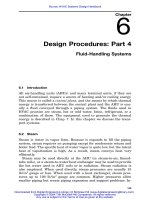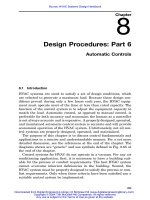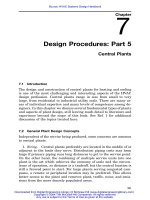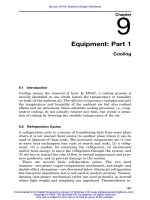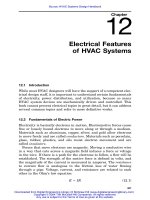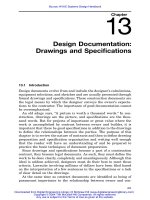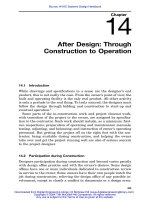Tài liệu HVAC Systems Design Handbook part 15 pptx
Bạn đang xem bản rút gọn của tài liệu. Xem và tải ngay bản đầy đủ của tài liệu tại đây (73.74 KB, 8 trang )
439
Chapter
15
Technical Report Writing
15.1 Introduction
An HVAC designer is almost certain to be faced with the need to write
reports. The ability to produce an organized, understandable, and suc-
cinct report will go far toward establishing credibility with both su-
periors and clients.
Writing a good report requires the same attributes needed for suc-
cess in any other area: understanding of basic principles, planning and
organization, and careful investigation.
Most reports are written in response to a problem, and describe the
results of a study of that problem and its possible solutions. Thus, the
problem-solving pattern outlined in Sec. 1.2 applies.
15.2 Organization of a Report
Figure 15.1 shows a typical report outline. There may be additional
topics, but these are the essential items in any report.
Section 1 is sometimes called an executive summary because it is
written for the executive who is not concerned with details but needs
a synopsis.
The authorization describes the purchase order, letter, or other legal
basis which led to the production of the report.
The scope is usually a part of the authorization and describes the
objective and problems to be addressed. It is really a specification, and
often provides the basis by which the report is judged for completeness
and payment is authorized. Definition of the scope is the first step in
the problem-solving process, and the value of the final report will re-
late strongly to the clarity of this definition.
Source: HVAC Systems Design Handbook
Downloaded from Digital Engineering Library @ McGraw-Hill (www.digitalengineeringlibrary.com)
Copyright © 2004 The McGraw-Hill Companies. All rights reserved.
Any use is subject to the Terms of Use as given at the website.
440 Chapter Fifteen
Figure 15.1
Typical report outline and table of contents.
The acknowledgments provide recognition for those in the owner’s
organization who provided information for the report and assisted the
report writer.
The summary is a synopsis of the material contained in the rest of
the report and follows the same sequence.
The recommendations are based on the summary and represent the
report writer’s professional opinion. Ideally, the recommendations
should be completely objective. In practice, they are always influenced
to some degree by subjective considerations. The true professional will
recognize and allow for some subjectivity.
Technical Report Writing
Downloaded from Digital Engineering Library @ McGraw-Hill (www.digitalengineeringlibrary.com)
Copyright © 2004 The McGraw-Hill Companies. All rights reserved.
Any use is subject to the Terms of Use as given at the website.
Technical Report Writing 441
The whole of Section 1 should not exceed two or three pages, one or
two figures, and a summary table.
The rest of the report is composed of detail, as complete as possible
but not verbose. Note that the summary follows the same sequence as
the body of the report. Lengthy data summaries and calculations
should be placed in an appendix. This material exists only to prove
the conclusions of the report.
15.3 Writing with Clarity
Technical writing deals with factual data in objective, nonemotional
ways for the purpose of presenting information on which to base de-
cisions. Most technical reports are written not only for technical people
but also for management and financial people, who may understand
very little about the technical aspects. It is therefore necessary to use
technical detail but to express it in simple terms, so that the audience
can at least understand the principles involved.
The following suggestions should be helpful:
1. Technical terms should be defined or made clear in context.
2. Proceed stepwise, from the known to the unknown. The use of syl-
logisms, as employed in logical proof, is sometimes helpful. A syl-
logism consists of two premises or facts which, taken together, lead
to a conclusion. When the steps become very detailed, complex, and
lengthy, it may be desirable to simply say, ‘‘It can be shown.’’ The
proof can be included in the appendix, if needed.
3. Make sentences as simple and direct as possible. Avoid overly com-
plex sentences with many phrases or clauses.
4. Writing should be factual. Any opinions expressed should be based
on the writer’s proven expertise and should be identified as opin-
ions. Avoid subjective and emotive adjectives. These have no place
in technical writing. Also avoid phrases like it is clear that or it is
apparent. Do not use cliche´s.
5. Follow accepted grammatical rules concerning punctuation, syntax,
agreement, and case. Grammatical errors reduce credibility.
15.4 Use of Tables and Figures
Figures and tables are useful in clarifying and summarizing a report.
Often they can be used to capsule the report, with the text serving as
an explanation of the data.
Figures can include any appropriate material, but usually consist of
schematics, bar and line graphs, or pie charts. Tables can be used to
Technical Report Writing
Downloaded from Digital Engineering Library @ McGraw-Hill (www.digitalengineeringlibrary.com)
Copyright © 2004 The McGraw-Hill Companies. All rights reserved.
Any use is subject to the Terms of Use as given at the website.
442 Chapter Fifteen
summarize data that may take several pages of text to describe. Pho-
tographs are very useful in describing existing conditions.
These are the basic rules in preparing figures and tables:
1. Neatness counts. Good line work and lettering are required. The
best written report may suffer from poor graphics.
2. Keep figures and tables as simple as possible. Avoid the use of data
and detail which are not pertinent.
3. Organize tabular data in the same sequence as that used in the
text. A good table can stand alone, through the use of clarifying
notes, with little or no text required.
4. While it can be helpful, color is seldom used or required in engi-
neering reports. Contrast can be achieved by shading, crosshatch-
ing, and variations in line width. The many stick-on halftone pat-
terns used by commercial artists are helpful here.
15.5 Printing and Binding
The relatively recent developments in word processing capability,
through the use of software programs run on a personal computer,
have brought near publishing-house-quality document preparation to
the engineering office, large or small. The quality of the final-copy
reading material still depends on the ability of the typist and artist
and on the nature of the software and the printer used, but the char-
acter of most material has been advanced by these modern techniques.
With word processing software, it is possible to incorporate graphics
into the body of the text, to scan previously prepared material includ-
ing photographs, and to print in high-quality formats with al-
most endless variations of type style and size. Text can be right- and/
or left-justified or can be centered as desired.
Many offices use standard formats and forms for report presenta-
tion. Figure 15.2 illustrates a report form sheet which may be used to
include text, tables, and figures. A design firm may be known to some
extent by the quality of its report formatting and presentation.
Document quality is further defined by the printer used to make the
camera-ready copy. Dot matrix printer technology has evolved to near
typeset quality, but so-called laser printers go one step further and
make a product almost indistinguishable from set type. Both dot ma-
trix and laser printer manufacturers have developed color-capable
products.
The reproduction method for office reports has evolved to photo-
copying or offset printing. Mimeograph and ink stencil work are in the
past. The office copy machine has become so economical and conven-
ient that it dominates most small-volume copy work. Larger runs or
Technical Report Writing
Downloaded from Digital Engineering Library @ McGraw-Hill (www.digitalengineeringlibrary.com)
Copyright © 2004 The McGraw-Hill Companies. All rights reserved.
Any use is subject to the Terms of Use as given at the website.
Technical Report Writing 443
Figure 15.2
Report page format.
high-profile reports may be candidates for outside reproduction ser-
vices.
Many engineering offices have standard report formats and ‘‘report
form’’ sheets which include the company logo and borders for report
pages. See Fig. 15.2.
There are many binding methods available, ranging from three-ring
looseleaf styles to mechanical clip systems to standard bound-book
Technical Report Writing
Downloaded from Digital Engineering Library @ McGraw-Hill (www.digitalengineeringlibrary.com)
Copyright © 2004 The McGraw-Hill Companies. All rights reserved.
Any use is subject to the Terms of Use as given at the website.
